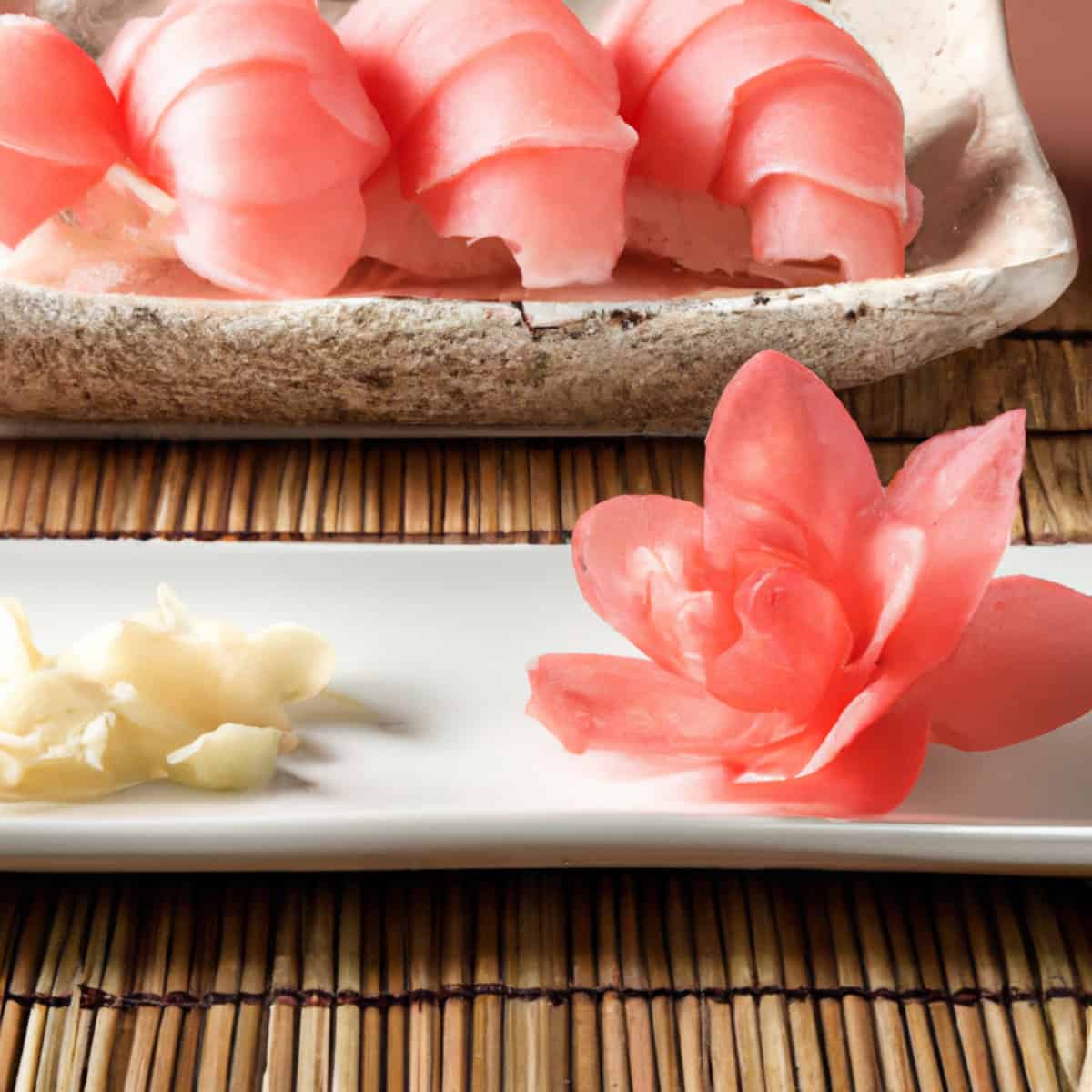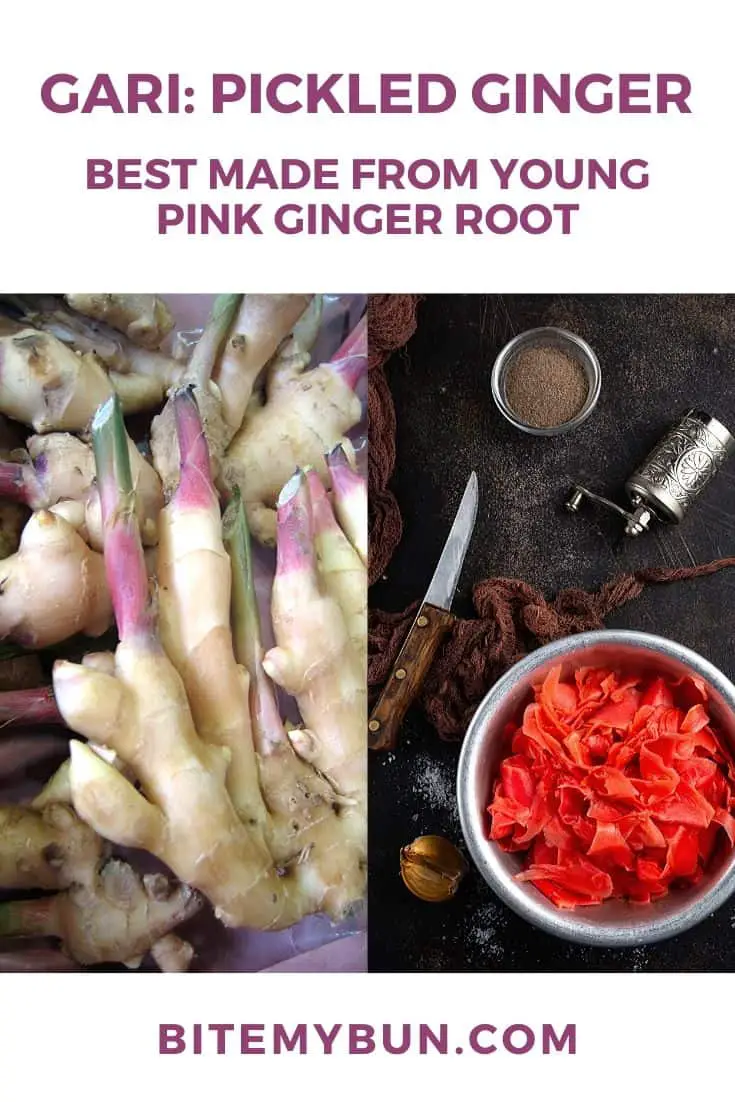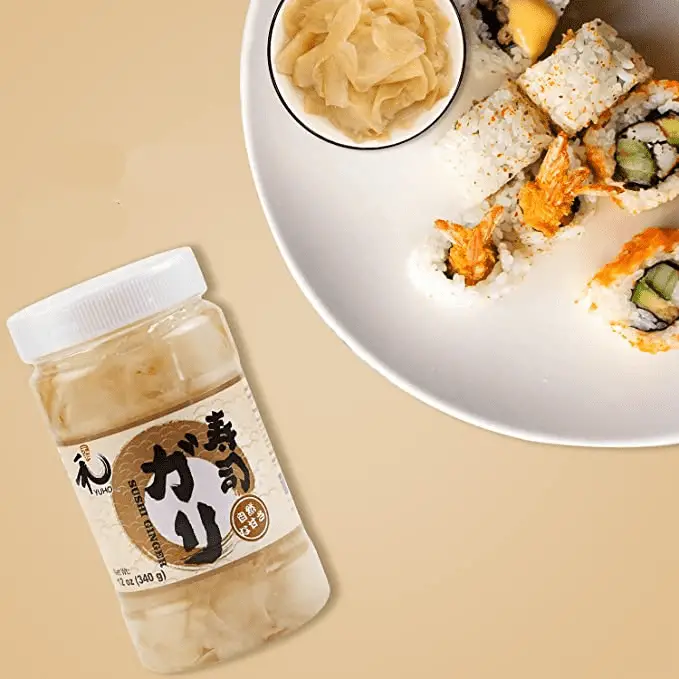Gari: Japanese Young Pickled Ginger for Sushi
We all love and use ginger in some form. In Japan, though, the use of ginger is quite diverse and pretty unconventional, and you may have heard of gari. But what is it exactly?
Gari is a type of tsukemono made from thinly sliced young ginger rhizomes. Instead of relying on the ginger’s natural spiciness, it is made sweeter, milder, and slightly sour through pickling in sweetened rice vinegar. It’s one of the most common side dishes of sushi.
Let’s go through everything you need to know about this unique pickle, from its very name to its uses, health benefits, and anything in between.


Check out our new cookbook
Bitemybun's family recipes with complete meal planner and recipe guide.
Try it out for free with Kindle Unlimited:
Read for freeIn this post we'll cover:
- 1 What is gari?
- 2 What does “gari” mean?
- 3 What does gari taste like?
- 4 How to eat gari?
- 5 Origin of gari
- 6 Gari vs. beni shoga
- 7 Popular gari pairings
- 8 Main ingredients of gari
- 9 Where to eat gari?
- 10 How to make gari?
- 11 Pink vs white pickled ginger
- 12 Where can you buy pickled ginger?
- 13 Is gari healthy?
- 14 Does pickled ginger kill bacteria in sushi?
- 15 Are you supposed to put ginger on the sushi?
- 16 Conclusion
What is gari?
Gari is a Japanese tsukemono made with a young ginger rhizome that has been thinly sliced and marinated in a rice vinegar and sugar solution.
It can be made with both young and mature ginger.
However, young ginger is preferable given that it has a more tender skin and a relatively milder taste with some natural sweetness, both ideal for pickling.
Gari is often served with sushi since it easily eliminates any aftertaste lingering in your mouth as you take your next bite.
Moreover, as it has an antibacterial effect, it also kills any bacteria that might otherwise grow in your body and pose gastrointestinal problems.
You will generally find gari in sushi restaurants. However, as you move from restaurant to restaurant, you will come across two types of gari.
One has a slightly pinkish-white color, while the other has a candy color. The one with white-pinkish color is made with shin-shoga, while the candy color is made with ne-shoga.
As you try both, you will know that shin-shoga has a sweet, mild taste, while ne-shoga has a super-intense, explosive flavor.
There are two reasons for that. The first one is the season they are grown in, and the other is the preparation method.
To explain more, the shin-shoga gari (or shin-shoga no Amazu-zuke) is made with young ginger (or rhizomes) grown in late summer.
The preparation method is quite simple.
Fresh ginger is obtained, cut against the grain into super thin slices, and then cured for several days or months before being put on the table.
On the other hand, ne-shoga gari is made with fresh ginger harvested in autumn and then kept in a storage shed for at least two months before pickling.
After being stored for such a long time, the ginger becomes candy-colored, and its original taste becomes more intense, with a more pungent aroma.
When marinated in sugar and vinegar, the ginger becomes sweet, with its original- gingery spiciness intact.
Compared to shin-shoga, ne-shoga has a deeper and more complex flavor, and is the most common among the two.
What does “gari” mean?
Gari (ガリ) is a Japanese word that initially meant ginger.
However, as pickled ginger became increasingly popular in Japanese culture, the meaning of the word evolved, only to be specifically used for ginger pickled in sweet vinegar later.
Right now, the word used for common ginger is “Shōga,” julienned ginger pickled in ume vinegar is “beni Shōga,” and “gari” is only used for thinly sliced ginger pickled in rice vinegar.
Though beni shoga and gari might look the same to an unfamiliar eye, they should not be confused with each other.
What does gari taste like?
Depending on which variety of gari you eat, the taste can range from super sweet herbaceous with weak hints of spiciness to mildly sweet with strong hints of spiciness.
It all comes down to whether the ginger is harvested in autumn or late summer, as mentioned earlier.
Generally, the one harvested in autumn tends to be more savory, given that it is always kept in the storage shed before pickling.
The ginger, harvested in late summer, is pickled fresh and has a pleasant aroma and sweet taste. It isn’t that spicy.
The pink color comes from the pink tips of fresh young ginger.

Japanese sushi chefs prefer young ginger for pickling because its thin skin is easy to peel. Plus, its flesh is still tender, which makes it easy to slice thinly.
Young ginger is difficult to harvest, as it only grows in the spring.
This is why it’s more commonly found at international markets than in your local supermarket; needless to say, it’s expensive!
However, even the older ginger (called “golden hands”) that’s widely available in grocery stores can be prepared and made to look like pink pickled ginger as well.
You might expect to use different kinds of knives to peel ginger.
But you’d be surprised to find out that a spoon is a much more efficient tool to use when peeling ginger, whether young or mature!
How to eat gari?
When you eat sushi, your plate will likely have a bunch of different fish meats. The chef carefully selects all these pieces to give you a taste of amazing flavors. These fish cuts are often sided with gari.
Most people who haven’t eaten sushi before often like to top the fish cut with the ginger. But that’s not correct according to tradition.
When eating sushi, remember that gari is only there to clean the palate.
As different fish cuts have different and unique tastes, eating gari in between ensures that you experience the real flavor of each cut to its fullest without being overpowered by the previous one.
Besides, gari is also eaten this way due to its antimicrobial properties, as there’s always a risk of food poisoning associated with raw foods.
You will be surprised to know that ginger served as a towelette in the initial days…when people primarily used to eat sushi with their hands.
Only recently, people started eating sushi with chopsticks, and the ginger on the side assumed more of a condimental role.
Some people also like to eat it after finishing their sushi to cleanse their system. I recommend eating it in between to enjoy your sushi to its fullest!
Origin of gari
The origin of gari, or tsukemono in general, dates back to 8th century Japan.
It was a time when pickling was a prevalent practice among Japanese people to make food last for several days…or even months.
Initially, Japanese people used sea salt for pickling their food.
However, as time passed, the pickling techniques got more refined with time, and the introduction of vinegar led us to the modern sushi ginger that we all love equally.
As for other tsukemono, more modern methods like inoculating cultured molds are also used.
Gari vs. beni shoga
Gari and beni shoga are both made from pickled ginger. In fact, they even look the same to an unfamiliar eye.
Then the question arises, what is it that makes them different?
Well, first, beni shoga is made from julienned ginger, while gari is made with thinly sliced ginger, much like paper thin cuts.
The next difference is the main ingredients- gari uses rice vinegar, while beni shoga uses ume vinegar.
This, in turn, translates into two completely different taste profiles.
Gari generally has more of an extra sweet taste. In contrast, beni shoga has a pretty mild sweetness with a defined sour taste, and a little spiciness.
Last but not least, both have different uses.
Gari is often served with sushi and sashimi, and beni shoga is usually added as a topping on several different dishes or, sometimes, sided with different meals to complement their overall flavor.
One thing common between both? They are made with ginger, and they are downright delicious!
Beni shoga is one of the traditional ingredients in takoyaki? Try this Beni Shoga Takoyaki Recipe With Takoyaki Sauce
Popular gari pairings
While gari, as you know it, is most closely associated with fish, you can pair it or add it to many unique dishes to make them more palatable.
The most common ones include salads.
You can mix gari with wasabi or grilled chicken and shrimp, or maybe with some other crisp vegetables, as well as seafood. The combination is beautiful!
If you are looking forward to putting it to more creative use, you can add it to your favorite marinades for poultry and meat.
The ginger infuses some unique, herby flavors to the meat that manifests in explosive flavors when seared, grilled, or smoked. The same stands for lamb too.
In other words, although ginger pickle has a reputation as merely a palate cleanser, it is equally great as a tastemaker, condiment, and garnish.
Just be careful about the spices you combine them with. The sweetness of gari goes well with a very selective number of spices.
Main ingredients of gari
Gari uses very few ingredients, including ginger, rice vinegar, salt, and sugar.
Although the rest of the ingredients are very readily available, finding young ginger can be quite a hassle, especially if you live outside Asia.
You will only find it at the peak production time, ideally, April and May.
In these seasons, young ginger is available for quite a reasonable price (still more expensive than mature ginger).
Although some farmers grow these in greenhouses for year-round availability, they are costly. You can use mature ginger to make gari if you cannot find young ones.
However, it is far more difficult to cut thinly, and the taste is too pungent to make something sweet out of them.
In other words, it’ll work, but you won’t get that authentic experience.
Where to eat gari?
You will find gari in every sushi restaurant there is, in, or outside of Japan.
It’s simply part of the dish, and no sushi is complete without a sweet, cleansing touch of pickled ginger.
If you don’t want to go to a sushi restaurant just to eat some pickled ginger, you can also buy it in packs from your nearest Asian stores and… Amazon.
How to make gari?
If you are feeling culinary, you can always make your own Japanese pickled ginger at home and eat it with any of your favorite meals.
The recipe is easy, and the ingredients are readily available (in the right season) at any of your nearest stores.
Keep the following in mind when you want to make this condiment yourself:
- Use young ginger rhizomes if you want to make the best pickled ginger.
- Don’t cut off the red pigment on the stem of the ginger root, as this is necessary to have that beautiful soft pink color in the pickled ginger.
- Wash and scrub the rhizomes well (you don’t always need to peel them since young ginger root has thin skin).
- Thinly slice the ginger rhizomes preferably at about 1/16th inch thick, parboil, and then squeeze out the excess water.
- Pour the vinegar mix while it’s still hot and freshly cooked from the stove.
While making gari does not require any Masterchef-level skills, it sure needs some effort to be made to perfection.
Steps to make your own gari
If you find this article in the right season and the right time, the following are all the steps you will need to follow to make a delicious jar of gari:
Preparing the ginger
Step 1 to making gari, as you will already know, is to prepare ginger.
Here, you will need to peel off the brown spots and skin from the ginger with the help of a spoon.
Once perfectly clean, get your peeler, and slice the ginger as thinly as possible.
You can also use a knife or mandolin for the task, but I love a peeler, as it makes paper-thin cuts.
Dehydration
When the ginger is perfectly sliced, the next thing you will need to do is to dehydrate the ginger.
It is necessary because you would like the ginger to absorb as much pickling solution later as possible.
For dehydration, you will need to mix some salt with the ginger slices and let them sit for at least half an hour.
You can also press slices with something heavy throughout the duration to extract maximum water.
Blanching
After the ginger is perfectly dehydrated, the next step is to remove all the extra spiciness from it so that the flavor remains sweet.
Thus, you would like to blanch the ginger in boiling water for a few moments.
If you want the spiciness to be super mild, you would like to blanch it for two minutes.
However, if you want it to retain the ginger’s natural flavor, a minute and a half would be enough.
Maturation
When the ginger has been blanched perfectly, put the slices in a sieve, and as it dries, start making your sweet vinegar.
The ingredients are simple. All you need is rice vinegar and sugar, and simmer them until the sugar is completely dissolved.
After that, just let the mixture cool, and pour it into the jar where you’re storing the ginger.
Now close the lid tightly, wait for a day or two, and voila! You have a great gari to enjoy.
Taming ginger’s heat
In case you’re going to use mature ginger to make your gari, then be sure to cure it quickly (and cook it lightly) and add salt before you pickle it.
This is because it’s a bit tougher and fiercer than fresh young ginger.
Marinate the sliced ginger with kosher salt and leave it in a small bowl for 35 minutes before you pickle it.
The salt is meant to make the ginger tender and also tame its heat.
Pink vs white pickled ginger
Making gari from young ginger is easier because it has a natural pink pigment, whereas the older ones change from golden-yellow to brown.
But you can also make pink pickled ginger from mature ginger. All you need to add is a single red radish to the mix when you pickle the ginger.
This method is optional, as it’s always recommended that you use young ginger to make gari.
Still, you may encounter white or beige gari in many sushi restaurants these days, and when you do, then you’ll know that the gari is made from mature ginger.
There were some cases where patrons of a sushi joint thought that the pink pickled ginger was made using artificial food coloring and rejected it right off the bat.
This prompted chefs to just prepare their gari without any additives or use mature ginger in order to appease their guests.
Where can you buy pickled ginger?
I used to head out and look for Japanese shops that almost always have pickled ginger. The local Chinese markets sometimes have it as well.
Now I regularly just order it online whenever I don’t want to make it myself for a quick addition to a dish I’m preparing.
My favorite brand right now is this YUHO Japanese White Gari Sushi:

Is gari healthy?
If you love pickles, ginger is one of the healthiest foods you will ever try, and there are reasons for that.
Following are some great health-related things everyone should know about gari.
Top 5 health benefits of pickled ginger

- Pickled ginger contains gingerol, a naturally occurring chemical compound that has strong anti-inflammatory and antioxidant properties.
- It can help treat many types of morning sickness or nausea.
- It can also reduce muscle pain and soreness (this is good for you gym rats!).
- It has the ability to lower blood sugar levels and improves your overall cardiovascular system.
- It treats chronic indigestion. If you suffer from indigestion, eating more pickled ginger can help you overcome most of the issues you’re experiencing.
It’s rich in antioxidants
According to a study conducted in 2004, gari contains about 50 different types of antioxidants.
These antioxidants are crucial in protecting your body against many cell-harming contaminants.
Thus, it not only improves your skin tone but also improves its overall texture.
With regular use, your skin will glow naturally. Moreover, the anti-inflammatory compounds found in it help improve your gastrointestinal health.
It also helps with morning sickness, so that’s another great thing about eating ginger!
It’s rich in nutrients
Did you know that little ginger can give you all the nutrients you need for the day without putting any bulk on your body?
Gari is super-rich in nutrients, and only 1 oz of it has just enough potassium, magnesium, copper, and manganese to fulfill at least 5% of your daily protein requirements.
Though the pickling reduces its overall nutritional value by some margin, it’s still good enough.
It helps with weight loss
A study conducted in 2009 found that consuming about 15 ml of vinegar regularly can help you lose excess fat along your waist, as well as other parts of the body.
Since gari is made with vinegar, it can also have the same effects, though it might not be in the same capacity.
Does pickled ginger kill bacteria in sushi?
Actually, wasabi is used to kill the bacteria in sushi and you eat pickled ginger as a side dish to help improve digestion and cleanse your palate.
Although it’s said that the shogaol (which is in ginger and gives it its strong taste) does kill bacteria as well!
Are you supposed to put ginger on the sushi?
A lot of readers asked how exactly you’re supposed to eat ginger at a sushi restaurant.
Because it’s served alongside wasabi and soy sauce, some think you should put the pickled ginger on the sushi as well to enhance its flavor.
But you shouldn’t put ginger on top of your sushi! The flavors aren’t supposed to mix and the ginger is there to eat as a separate bite.
Conclusion
And there you go! Now you have all the essential stuff you need to know about gari.
I hope this article has been helpful in expanding your information on Japanese cuisine in general and gari in specific.
When are you trying it out with your homemade sushi?
Check out our new cookbook
Bitemybun's family recipes with complete meal planner and recipe guide.
Try it out for free with Kindle Unlimited:
Read for freeJoost Nusselder, the founder of Bite My Bun is a content marketer, dad and loves trying out new food with Japanese food at the heart of his passion, and together with his team he's been creating in-depth blog articles since 2016 to help loyal readers with recipes and cooking tips.
